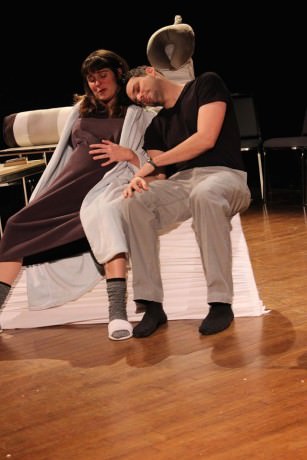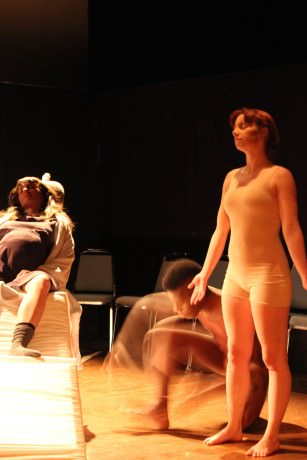StillPointe Theatre Initiative’s The Benefactor is a production that a million people will want to see, but there’s only room for about three dozen audience members at each show.
Be a Theatre Insider and get there before it’s sold out.

This is a play audiences will chew over, dissect, and argue about for years to come. The cast is to be commended for their first-rate acting. That is, acting with a small, realistic “a” – not Look At Me over-the-top acting with a big “A.”
You watch the actors sweat as they live their roles.
In this play, with a stunning, thought-provoking book by Kimberley Lynne and sensitively directed by Amanda J. Rife, the audience has to think inside the box because they are inside a box. Trapped.
As the audience files into what is, traditionally, the seating area for StillPointe Theatre Initiative, they find, instead, a casual, hipster bar and art gallery set up. There are plenty of overstuffed chairs and couches to go around while you enjoy a cup of wine or a NattyBo.
Off to one side, some audience members are playing with an interactive dance program. An artist is setting up his paintings. A voice on a loudspeaker makes the usual announcements about silencing electronics, yada yada, but is emphatic that we visit the restroom. NOW.
The strange, authoritarian voice speaks again. Ordering us to remove our shoes before entering the show space.
We were herded through a narrow, sliding door into a black box set designed by Nolan Cartwright. Cailtin Rife is the stage manager.
Seats lined the box’s four sides, with some spaces provided for the door; a large bloody, swirling painting hanging on the center rear wall; and two other narrow, closed doors.
The enclosure walls, painted black, were about eight feet high. Overhead, the church’s gothic wood beam ceiling soared into darkness.
The door slides shut behind us. We’re here for the duration.
Stage left is the show’s major prop, a structure resembling an obstetric examination bed swathed in sheer white ruched fabric,. Between scenes, when the entire space was blacked out, a light glowed rhythmically from beneath the chair and the heavy, pulsing throb of a heartbeat pushed out all other sound.
During most of the performance, a series of subtly haunting instrumental sounds, designed by Daniel Benbow, were piped in by Sound Engineer Stephen Frank. The music was created by Daniel Benbow and Erica Patoka.
Actors in The Benefactor were skilled at pantomiming their usage of laptops, tablets and monitoring equipment, all props designed by Ryan Michael Haase. A curved frosted glass plate and an angled piece of white plastic became the creative substitutes. In this world, paper books and notebooks are curiosities, objects of the past.
A see-all surveillance camera, watching the goings-on in the tiny space, was suggested by a white globulaor glass light shade suspended in the far right corner.
The audience, perhaps, were the real cameras, spying into the lives and secrets unspooling in the small room. After all, we are only inches from this realistic unreality.
The author stated in the abbreviated program notes The Benefactor “began as a bit of a tretise, a warning of a possible future world that’s a meld between The Handmaiden’s Tale and Blade Runner, evolved into a mysterious love story …” She had been concerned about the “conservative swing in American politics and the reports of gender ratio inequality in Asia.”
In China, especially, with the one-child per family rules imposed during Mao’s rule, many couples choose to abort female fetuses – or, as they have for centuries, toss female newborns off the nearest bridge. Male children are more desirable. There are some villages where the younger generation is almost all male.
The Benefactor is set in the near future in Manhattan. A “New Order” has swiftly, within just several decades, taken over the planet.
It is a male-dominated world. Where women were once more than 51 percent of the population, their numbers are vastly lower than that. They are an endangered gender. The women who remain have no rights to property, education, voting or to raise their own children.
Their children – all males – are not their own. They are taken away at birth to be raised by others.
There was a brief struggle, but the battle of the sexes appears to be over.
Forms of government have changed, too. Corporations now own countries – maybe they took a cue from the Koch Brothers? GE now owns Greece.
When the lights come up, Judith (Courtney Proctor) is seated in the chair, obviously in the latter stages of a pregnancy. She is a former painter and activist who now survives as a professional surrogate, in her words “a breeder who births boys with high I.Q.s for a living.”
The room is tightly monitored and secured by her midwife Maria (Joan Weber), a tyranical Nurse Nancy who guards and safeguards Judith. Among the things Maria doesn’t want in the room are germs, disruptive visitors, news of current events or subversive ideas. Unlike many of her generation, Judith knew both her parents and was raised by them. She was permitted to attend college – NYU – before the planet tilted.
During her entire pregnancy, Judith has not been allowed to leave the building in which she is confined. To ensure compliance, Maria prowls like a protective pit bull.
David Phoenix (Derek Vaughan Brown), a writer, is given permission to visit. He is ghost writing a book and needs to learn a woman’s voice for his draft. He’s not familiar with women. The number of visits are established, conditions set out, a contract is signed.
He was hired by The Benefactor, a wealthy person born in Mahwah, New Jersey.
In a series of visits, as they discuss art, sexual preferences and more. The two opposites become drawn into a bond of friendship.
Hamilton (Michael Stevenson) has an equally natural performance in his exchanges with David.
Between scenes, four spectral dancer-figures (Amanda Boutqell, Lawrence D Bryant IV, Corey Hennessey, and Marissa O’Guinn) clad in second-skin costumes created by Danielle Robinette, slither into the space either sliding through the doors or by lifting up the painted canvas and silently dropping onto the floor.
Their otherworldy hair and makeup was by Mitchel Brower. The creatures are choreographed by Judy Kurjan-Frank.
Speechless, they crawl and writhe on the old wooden floor. In one scene, three wolf down slices of bread and appear to fight over the crumbs. In another, a male figure dips his hands in paint and proceeds to add to the ghastliness of the painting.
What or who are they? They could be Judith’s tortured thoughts and emotions. They could be the hopes and yearnings of the children she has carried – and the one inside her. They could be her heartbeats.
Their performance – call them scene stealers – adds to the mystery and intimacy of the show.

While it could happen here, one hopes The Benefactor, a fictive but fascinating look into the future, remains solidly in the realm of fiction.
Running Time: Almost 90 minutes, with no intermission.
The Benefactor plays through February 21, 2015 at StillPointe Theatre Initiative performing at Emmanuel Episcopal Church – 811 Cathedral Street, in Baltimore, MD. For tickets, purchase them online.
RATING:




